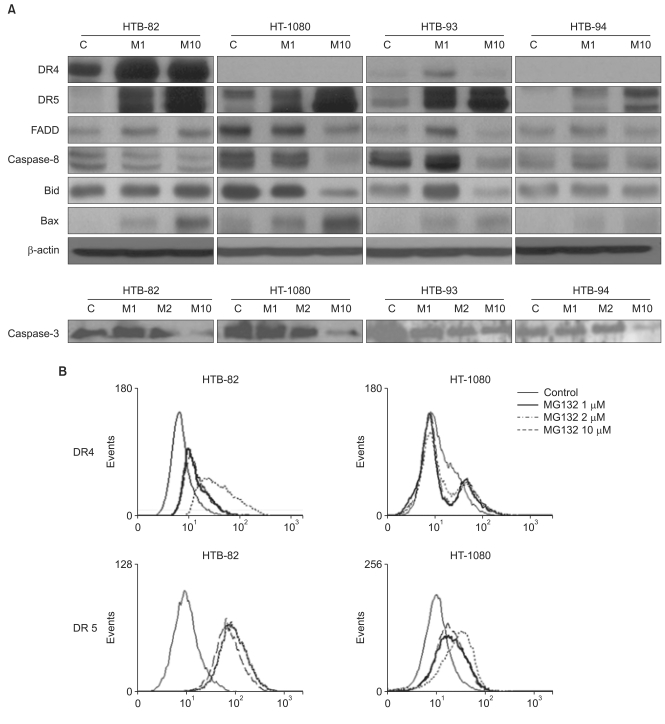Introduction
Materials and Methods
1. STS cell lines
2. Measurement of cell viability
3. Western blot analysis
4. Measurement of surface expression of TRAIL receptors
5. Statistical analysis
Results
1. Cytotoxic effects of TRAIL and MG132 in STS cell lines
 | Fig. 1Cell viability of soft tissue sarcomas (STS) cell lines treated with tumor necrosis factor-related apoptosis-inducing ligand (TRAIL), MG132 and a combination of both agents. (A, B) Cells were incubated for 24 hr in the presence of different concentrations of TRAIL and/or MG132. *p<0.05, compared to control or lower dose of each treatment. Cell viability was quantified by MTT assay; each treatment was performed in triplicate. (C) Adding MG132 to TRAIL augmented the apoptosis compared to exposure to a single agent, TRAIL or MG132, in TRAIL-sensitive cells (HTB-93) and TRAIL-resistant cells (HTB-82, HT-1080, and HTB-94). *p<0.05, compared to TRAIL 10 ng/mL, MG132 1 µM, and MG132 2 µM. (T10/M1: 10 ng/mL TRAIL+1 µM MG132; T10/M2: 10 ng/mL TRAIL+2 µM MG132). |
2. Enhancement of TRAIL-induced apoptosis in STS cell lines by co-treatment with the proteasome inhibitor, MG132
3. Detection of apoptosis
 | Fig. 2Evaluation of apoptosis. The broad-spectrum caspase inhibitor z-VAD-fmk or the caspase-8 inhibitor z-IETD-fmk was applied for 1 hr before treatment of soft tissue sarcomas (STS) cells with tumor necrosis factor-related apoptosis-inducing ligand (TRAIL) and MG132 for 24 hr. (A, B) The decrease in cell viability induced by combined treatment with MG132 and TRAIL and measured by MTT assay was caspase dependent. Similar results were obtained in three separate experiments. *p<0.05 compared to the combination of TRAIL and MG132. |
4. Expression of apoptotic proteins and sensitivity to TRAIL
 | Fig. 3Expression of tumor necrosis factor-related apoptosis-inducing ligand (TRAIL) receptors and apoptotic molecules in soft tissue sarcomas (STS) cells. (A) After incubating each of the four STS cell lines for 24 hr with different concentrations of MG132, expression levels of TRAIL receptors and apoptotic molecules were determined by western blot analysis. (B) Analysis of the surface expression of death receptor (DR)4 and DR5 was determined by flow cytometry in HT-1080 and HTB-82 cells. C, control; M1, 1 µM MG132; M2, 2 µM MG132; M10, 10 µM MG132. |




 PDF
PDF Citation
Citation Print
Print


 XML Download
XML Download